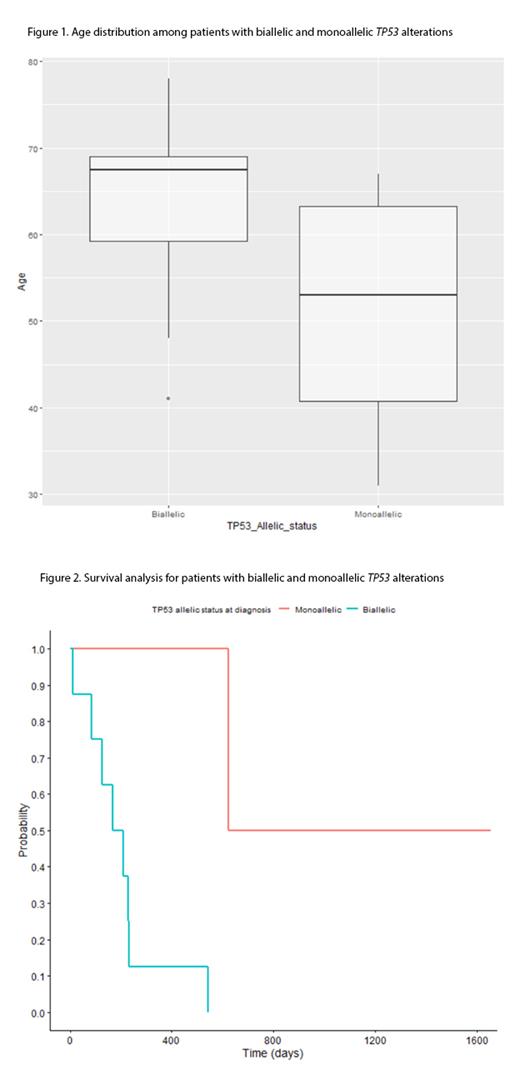Abstract
Introduction
TP53 is a tumor suppressor gene involved in regulating cell division and apoptosis in response to DNA damage. In hematologic malignancies, TP53 alterations are present in both myeloid and lymphoid malignancies. TP53 alterations including both sequence level mutations and deletions occur in 8-10% of de novo acute myeloid leukemia (AML), and are significantly enriched in patients with therapy-related myeloid neoplasms with a frequency of 25-40%. TP53 alterations are associated with complex karyotype, resistance to traditional cytotoxic chemotherapy and dismal outcome, and are well established poor prognostic markers for both AML and myelodysplastic syndrome (MDS). While both biallelic and monoallelic TP53 alterations are seen, biallelic TP53 alteration is more frequent in both AML and MDS. In the instances of monoallelic TP53 alterations, the remaining wild-type allele can be inhibited by the dominant negative effect of the mutant p53.
The clinical implication of TP53 allelic status remains controversial. Biallelic TP53 alterations and/or high TP53 mutation variant allele frequency (VAF) are associated with older patients, complex karyotype, few co-occurring mutations and poor outcome in both AML and MDS. Other studies demonstrate that biallelic vs. monoallelic TP53 alterations or high vs. low TP53 VAF have similar prognosis in myeloid malignancies. Current European LeukemiaNet (ELN) recommends testing TP53 deletion using karyotype analysis and TP53 mutations by molecular testing.
Methods:
We performed a retrospective review of patients with myeloid malignancies, myeloid next generation sequencing (NGS) panel and cytogenetic tests performed at ARUP Laboratories. We identified 18 patients with myeloid malignancies and TP53 mutations. We used a combination of karyotype analysis, FISH, chromosomal microarray (CMA) and NGS to determine the TP53 allelic status.
Results:
18 patients diagnosed with myeloid malignancies and TP53 mutations were identified. Among them, 6 were diagnosed with AML, 10 had MDS, one with CMML and one had post essential thrombocythemia myelofibrosis. Age range is from 31 to 78 with a median age 65.5 years.
23 TP53 mutations were identified among 18 patients. The majority (78%) of TP53 mutations are located in the DNA binding domain. Co-occurring mutations are uncommon in patients with TP53 mutations. 11 out of 18 patients did not have co-occurring mutations in other myeloid malignancy related genes. Three cases had 1, three cases had 2, and one case had 3 co-occurring mutations at the time of diagnosis.
Karyotype analysis and FISH were performed on all 18 patients. CMA was performed on 9 patients. 17p abnormalities, defined by the deletion or copy-neutral loss of heterozygosity (CN-LOH) of 17p, were seen in 9 out of 18 cases. The 17p abnormalities in 8 out of these 9 cases were visible by karyotype. Case 11 had a CN-LOH identified by CMA which was cryptic by karyotype. Typical complex karyotype was seen in 16 out of 18 cases.
Biallelic TP53 alterations are defined by either the presence of a TP53 mutation with a 17p abnormality (deletion or CN-LOH), or two TP53 mutations with similar VAF, or one TP53 mutation with VAF >50%. Biallelic TP53 alterations were seen more frequently compared with monoallelic TP53 alterations (14 vs. 4 patients) and enriched in older patients (Figure 1). All 6 AML patients had biallelic TP53 alterations.
Outcome data is available in 10 patients including 8 patients with biallelic and 2 patients with monoallelic TP53 alterations. Patients with biallelic TP53 alterations have dismal outcome (Figure 2). Patient 7 represents an atypical patient with TP53 alteration in our study cohort. She was diagnosed with MDS at the age of 31. She had monoallelic TP53 mutation with a relatively low VAF and normal karyotype through her disease course. Her MDS never progressed and she remained in remission after transplant for more than four years and still doing well.
Conclusion:
In this study, we evaluated the TP53 allelic status in 18 patients with myeloid malignancies. Biallelic TP53 alterations are more frequent than monoallelic TP53 alterations, and are associated with older patients, and fewer co-occurring mutations. Biallelic TP53 alterations are associated with typical complex karyotype and dismal outcome. Our study supports the importance to differentiate between biallelic and monoallelic TP53 alterations.
No relevant conflicts of interest to declare.


This feature is available to Subscribers Only
Sign In or Create an Account Close Modal